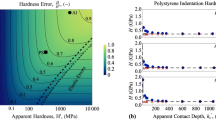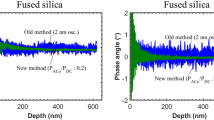Abstract
We propose a novel approach to determine the precise indent area using image processing with sub-pixel edge location in nanoindentation hardness testing. The impressions made by nanoindentation on copper and mild steel specimens were captured using a high-resolution optical microscope. Each indent area was cropped out and subjected to pixel-level edge detection using the Canny operator. Based on the detected edge the invariant moment sub-pixel edge location method was applied to determine the precise location of the edges of the indent using combined vertical and diagonal scanning. The projected area was then determined directly from the enclosed contour to sub-pixel accuracy. The hardness value was determined by dividing the load with the area determined using the proposed approach. Comparison of the hardness values was made using the area determined by sub-pixel edge location and that determined from the nanoindentation tests showed a maximum difference of about 3.74% for the copper specimen and 4.17% for mild steel specimen. Unlike in the actual nanoindentation test, the proposed method of determining hardness does not assume that the indentation area is triangular, thus resulting in higher accuracy hardness values.
Similar content being viewed by others
References
Yan, W., Pun, C.L., Wu, Z., and Simon, G.P., “Some Issues on Nanoindentation Method to Measure the Elastic Modulus of Particles in Composites,” Composites: Part B 42:2093–2097 (2011).
Lucca, D.A., Herrmann, K., and Klopfstein, M.J., “Nanoindentation: Measuring Methods and Applications,” CIRP Annals - Manufacturing Technology 59:803–819 (2010).
Saber-Samandari, S., and Karlis, A., “Gross Nano-Indentation on Amorphous Calcium Phosphate Splats: Effect of Droplet Size on Mechanical Properties,” Journal of the Mechanical Behavior of Biomedical Materials 16:29–37 (2012).
Harvey, E., Ladani, L., and Weaver, M., “Complete Mechanical Characterization of Nanocrystalline Al–Mg Alloy Using Nanoindentation,” Mechanics of Materials 52:1–11 (2012).
Jian, S.-R., and Lin, Y.-Y., “Berkovich Nanoindentation-Induced Dislocation Energetics and PoP-In Effects in ZnSe Thin Films,” Journal of Alloys and Compounds 590:153–156 (2014).
Oyen, M.L., “Nanoindentation of Biological and Biomimetic Materials,” Experimental Techniques 37(1):73–87 (2013).
Hang, W., Zhou, L., Shimizu, J., and Yuan, J., “A Robust Procedure of Data Analysis for Micro/Nano Indentation,” Precision Engineering 37:408–414 (2013).
Randall, N.X., “Direct Measurement of Residual Contact Area and Volume During the Nanoindentation of Coated Materials as an Alternative Method of Calculating Hardness,” Philosophical Magazine A 82(10):1883–1892 (2002).
Poon, B., Rittel, D., and Ravichandran, G., “An Analysis of Nanoindentation in Elasto-Plastic Solids,” International Journal of Solids and Structures 45:6399–6415 (2008).
Sakharova, N.A., Fernandes, J.V., Antunes, J.M., and Oliveira, M.C., “Comparison Between Berkovich, Vickers and Conical Indentation Tests: A Three-Dimensional Numerical Simulation Study,” International Journal of Solids and Structures 46:1095–1104 (2009).
Canny, J., “A Computational Approach to Edge Detection,” IEEE Transactions on Pattern Analysis and Machine Intelligence 8(6):679–698 (1986).
Tabatabai, A.J., and Mitchell, O.R., “Edge Location to Subpixel Values in Digital Imagery,” IEEE Transactions on Pattern Recognition and Machine Intelligence 6(2):188–201 (1984).
Fischer-Cripps, A.C., Nanoindentation. Mechanical Engineering Series, 3rd, ISBN: 978-1-4419-9871-2 Edition, Springer, New York, NY (2011).
Galbiati, L.J., Machine Vision and Digital Image Processing Fundamentals, Prentice-Hall, Upper Saddle River, NJ (1990).
Roh, M.-C., Kim, T.-Y., Park, J., and Lee, S.-W., “Accurate Object Contour Tracking Based on Boundary Edge Selection,” Pattern Recognition 40(3):931–943 (2007).
Author information
Authors and Affiliations
Corresponding author
Rights and permissions
About this article
Cite this article
Thoo, H.W., Ratnam, M.M. An Improved Method of Projected Area Determination in Nanoindentation Using Image Processing With Sub-Pixel Edge Location. Exp Tech 40, 803–818 (2016). https://doi.org/10.1007/s40799-016-0081-1
Published:
Issue Date:
DOI: https://doi.org/10.1007/s40799-016-0081-1




